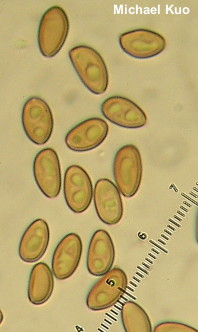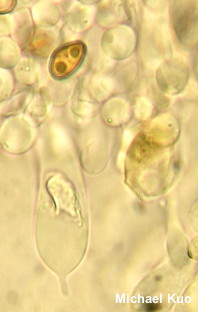| Major Groups > Gilled Mushrooms > Dark-Spored > Stropharioid Mushrooms > Stropharia coronilla |

|
[ Basidiomycota > Agaricales > Strophariaceae > Stropharia. . . ] Stropharia coronilla by Michael Kuo, 11 September 2024 This mushroom is likely to be mistaken for an Agaricus or an Agrocybe species if it is not closely examined; it grows in lawns and meadows, and has a yellowish-buff cap and a ring. But close inspection reveals important differences. The gills are pale at first, but soon become a very beautiful shade of purplish gray. And the ring is distinctive: it is usually grooved on its upper surface, and by the time the mushroom is mature, dark purplish spores have fallen onto it, accenting the grooves. Finally, the gills are attached to the stem, rather than being free from it as they are in Agaricus. Stropharia melanosperma is a very similar species that features a whiter cap, a longer, slimmer stem, and larger spores. Thanks to Andy Methven for documenting, collecting, and preserving Stropharia coronilla for study; his collection is deposited in The Herbarium of Michael Kuo. Description: Ecology: Saprobic; growing alone or gregariously on lawns, in pastures, and in other grassy places; summer and fall; originally described from France (Bulliard 1792); widespread in Europe and North America; reported from South America, Oceania, and Africa. The illustrated and described collections are from California, Colorado, Illinois, and North Carolina. Cap: 1.5–5 cm; convex, becoming broadly convex; sticky when fresh but soon dry; bald; golden yellow to brownish yellow when young and fresh, but sometimes fading dull orangish or pale yellow; margin when young with veil remnants, not becoming lined. Gills: Attached to the stem; close or nearly distant; short-gills frequent; pale at first, becoming purplish gray, then blackish. Stem: 2–6 cm long; 4–10 mm thick; equal, with a slightly tapered base; dry; bald or fibrillose; with a flimsy to persistent, white ring that is usually grooved on its upper surface and typically collects purplish gray spores; base sometimes with white mycelial threads. Flesh: White; unchanging when sliced. Odor and Taste: Not distinctive. Chemical Reactions: KOH on cap surface pale red to red or brownish red. Spore Print: Dark purple-brown to blackish. Microscopic Features: Spores 7–10 x 4–5.5 µm; amygdaliform, with a small pore; smooth; thick-walled; yellow-brown in KOH. Basidia 20–25 x 4–6 µm; clavate; 4-sterigmate. Leptocheilocystidia 30–40 x 6–10 µm; clavate or widely cylindric; thin-walled; hyaline in KOH. Chrysopleurocystidia 30–80 x 10–12 µm; clavate to fusiform, becoming rostrate; smooth; thin-walled; hyaline in KOH, with a refractive globular inclusion. Pileipellis a cutis, sometimes partially gelatinized; elements 2–5 µm wide; hyaline to golden in KOH. Clamp connections present. REFERENCES: (J. B. F. Bulliard, 1792) L. Quélet, 1872. (Fries, 1821; Kauffman, 1918; Stamets, 1978; Smith, Smith & Weber, 1979; Phillips, 1981; Arora, 1986; Schalkwijk-Barendsen, 1991; Lincoff, 1992; Metzler & Metzler, 1992; Breitenbach & Kränzlin, 1995; Noordeloos, 1999; Cortez & Coehlo, 2004; McNeil, 2006; Miller & Miller, 2006; Boccardo et al., 2008; Cortez & da Silveira, 2008; Ryman, 2008; Buczacki et al., 2012; Kuo & Methven, 2014; Desjardin, Wood & Stevens, 2015; Siegel & Schwarz, 2016; Gminder & Böhning, 2017; Ryman, 2018; Læssøe & Petersen, 2019; Kibby, 2021; McKnight et al., 2021.) Herb. Kuo 01130519, 11010901, 08041701, 05162403. This site contains no information about the edibility or toxicity of mushrooms. |
© MushroomExpert.Com |
|
Cite this page as: Kuo, M. (2024, September). Stropharia coronilla. Retrieved from the MushroomExpert.Com Web site: http://www.mushroomexpert.com/stropharia_coronilla.html |








